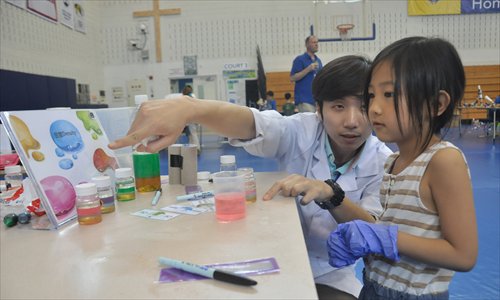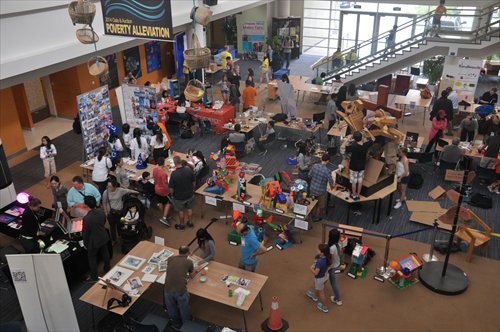HOME >> METRO SHANGHAI
The greatest show-and-tell in Shanghai
By Huang Lanlan Source:Global Times Published: 2015-5-10 19:43:01
"Would you like to try our chair?" asks 15-year-old Manon Miller to anyone stopping to look at the winged, cardboard chair placed in the center of the hall. This was no ordinary winged cardboard chair, mind you. It took Miller and her two teammates five weeks every day after school to design the structure, cut the cardboard and meticulously assemble the pieces. "Now the chair can hold at least 100 kilograms!" Miller grins.
In a global furniture showroom oversaturated with winged cardboard chairs, it was a bold move for Miller, a budding inventor, to invest all her time and resources in this chair. But with its 100-kilo bragging rights and grand wingspan larger than any other winged cardboard chair in the market, suitors such as IKEA will doubtless be lining up to bid on the patent rights.
Such was the frenzied action and dazzling displays of futurism at the Jinqiao Mini Maker Faire, where nearly 600 visitors came to view 120 inventions being showcased at Concordia International School earlier this month.
The right stuff
While Miller's crew were showing off their cardboard creation, 12-year-old Joshua Cheng sat quietly behind his booth peering into a big box that he cradled carefully in his arms. The box was filled with components of Cheng's handmade rocket, which he had successfully launched 10 storeys high out of the yard of his residential compound.
Though unauthorized flights are technically unlawful in Shanghai's strictly monitored airspace, the stealth, PVC-pipe construction of Cheng's rocket, filled not with rocket fuel but potassium nitrates, sugar and kitty litter, allowed the projectile to escape notice of airspace authorities.
Schoolyard buzz following the fair was that Cheng's inventions were made of the right stuff. Cheng, however, confided in the Global Times that his rocket was subject to numerous trial-and-error attempts before finally getting off the ground, not unlike China's own space missions. "I failed over 30 times before it launched. At first the fuel didn't work, and I kept finding new problems and thinking of solutions myself."
While it remains to be seen if China National Space Administration will want to incorporate his kitchen-ingredient technology into its aerospace programs, Cheng's father is confident in his son's future heights. "Our balcony has been converted into his own little lab," the proud father confirms.
At the big kid's corner of the scientific expo, 17-year-old Andrew Chang and his team are intent on delving into the world's depths with their 50-centimeter-long, 20-centimeter-tall underwater vehicle. Dubbed Trident, after the weapon of mythological sea god Neptune, the remote-controlled vehicle, which comes equipped with a camera that is linked to a small monitor, is intended to someday facilitate deep ocean technology.
"It can easily work underwater for longer periods of time and repair damaged pipelines faster when compared to the ability of humans," Chang told the Global Times, who said that he and his 10 teammates spent eight months making the vehicle. There was no mention of whether Chang's Trident will be fully operational by the time China's proposed 8,000-mile-long underwater train route to the US kicks off.
Little mad scientists
For 6-and-under scientists, the Mad Science booth was fizzing with formulas and percolating with concoctions as white-gowned staffers resembling muppet Dr Bunsen Honeydew and Beaker-like assistants poured multi-hued liquids into volumetric flasks.
"The word 'density' is a bit abstract to little kids, but today kids can learn that different liquids have different densities in a simple and fun way," said Mad Science staffer Wang Qi. A follow-up chemistry question to Wang about whether a volumetric flask is for general mixing and titration or for applying heat went unanswered due to the enthusiastic attendance of over 70 future Heisenbergs.
In 2013, event organizer Jennifer Chapman and her colleagues participated in a few Maker fairs in the US, where they were impressed as much by the inventions as they were the makers' imaginations and creativity. "The fair was great, so we thought that we could introduce it to Concordia," she recalled.
Mini Maker Faires are independently organized, small-scale offshoots of Maker Faire, a scientific DIY (do it yourself) celebration sponsored by engineering-oriented Make Magazine. This was the second year that Concordia held the Jinqiao Mini Maker Faire.
"It is a chance to learn and play," Chapman, pointing at her 9-year-old son, who was mesmerized by a roller coaster design booth, said, "and sometimes you can learn just by playing."


In a global furniture showroom oversaturated with winged cardboard chairs, it was a bold move for Miller, a budding inventor, to invest all her time and resources in this chair. But with its 100-kilo bragging rights and grand wingspan larger than any other winged cardboard chair in the market, suitors such as IKEA will doubtless be lining up to bid on the patent rights.
Such was the frenzied action and dazzling displays of futurism at the Jinqiao Mini Maker Faire, where nearly 600 visitors came to view 120 inventions being showcased at Concordia International School earlier this month.
The right stuff
While Miller's crew were showing off their cardboard creation, 12-year-old Joshua Cheng sat quietly behind his booth peering into a big box that he cradled carefully in his arms. The box was filled with components of Cheng's handmade rocket, which he had successfully launched 10 storeys high out of the yard of his residential compound.
Though unauthorized flights are technically unlawful in Shanghai's strictly monitored airspace, the stealth, PVC-pipe construction of Cheng's rocket, filled not with rocket fuel but potassium nitrates, sugar and kitty litter, allowed the projectile to escape notice of airspace authorities.
Schoolyard buzz following the fair was that Cheng's inventions were made of the right stuff. Cheng, however, confided in the Global Times that his rocket was subject to numerous trial-and-error attempts before finally getting off the ground, not unlike China's own space missions. "I failed over 30 times before it launched. At first the fuel didn't work, and I kept finding new problems and thinking of solutions myself."
While it remains to be seen if China National Space Administration will want to incorporate his kitchen-ingredient technology into its aerospace programs, Cheng's father is confident in his son's future heights. "Our balcony has been converted into his own little lab," the proud father confirms.
At the big kid's corner of the scientific expo, 17-year-old Andrew Chang and his team are intent on delving into the world's depths with their 50-centimeter-long, 20-centimeter-tall underwater vehicle. Dubbed Trident, after the weapon of mythological sea god Neptune, the remote-controlled vehicle, which comes equipped with a camera that is linked to a small monitor, is intended to someday facilitate deep ocean technology.
"It can easily work underwater for longer periods of time and repair damaged pipelines faster when compared to the ability of humans," Chang told the Global Times, who said that he and his 10 teammates spent eight months making the vehicle. There was no mention of whether Chang's Trident will be fully operational by the time China's proposed 8,000-mile-long underwater train route to the US kicks off.
Little mad scientists
For 6-and-under scientists, the Mad Science booth was fizzing with formulas and percolating with concoctions as white-gowned staffers resembling muppet Dr Bunsen Honeydew and Beaker-like assistants poured multi-hued liquids into volumetric flasks.
"The word 'density' is a bit abstract to little kids, but today kids can learn that different liquids have different densities in a simple and fun way," said Mad Science staffer Wang Qi. A follow-up chemistry question to Wang about whether a volumetric flask is for general mixing and titration or for applying heat went unanswered due to the enthusiastic attendance of over 70 future Heisenbergs.
In 2013, event organizer Jennifer Chapman and her colleagues participated in a few Maker fairs in the US, where they were impressed as much by the inventions as they were the makers' imaginations and creativity. "The fair was great, so we thought that we could introduce it to Concordia," she recalled.
Mini Maker Faires are independently organized, small-scale offshoots of Maker Faire, a scientific DIY (do it yourself) celebration sponsored by engineering-oriented Make Magazine. This was the second year that Concordia held the Jinqiao Mini Maker Faire.
"It is a chance to learn and play," Chapman, pointing at her 9-year-old son, who was mesmerized by a roller coaster design booth, said, "and sometimes you can learn just by playing."

Wang Qi from Mad Science shows a child the densities of different liquids.

The Jinqiao Mini Maker Faire
Photos: Huang Lanlan/GT
Posted in: Metro Shanghai